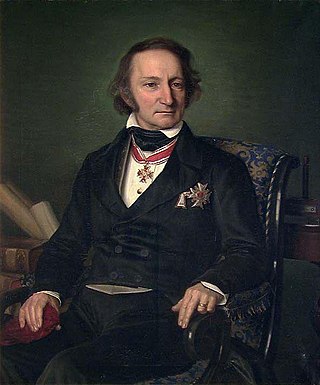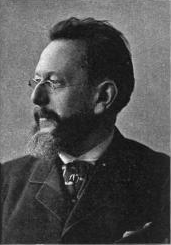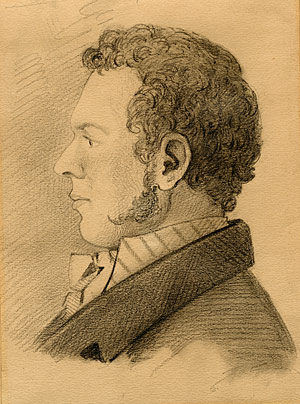Related Research Articles

Christopher Hansteen was a Norwegian geophysicist, astronomer and physicist, best known for his mapping of Earth's magnetic field.

Gunnar Edvard Rode Heiberg was a Norwegian poet, playwright, journalist and theatre critic.

Torolf Prytz was a Norwegian architect, goldsmith and politician for the Liberal Party. He led the goldsmith company J. Tostrup of Oslo from 1890 to 1938, having inherited it from his grandfather-in-law Jacob Tostrup. He also served as Norwegian Minister of Industrial Provisioning from 1917 to 1918 and President of the Norwegian Red Cross from 1922 to 1930.

Harald Viggo Hansteen was a Norwegian lawyer. He was executed during the Occupation of Norway by Nazi Germany.

Henrik Mohn was a Norwegian astronomer and meteorologist. Although he enrolled in theology studies after finishing school, he is credited with founding meteorological research in Norway, being a professor at the Royal Frederick University and director of the Norwegian Meteorological Institute from 1866 to 1913.
Rolf Wickstrøm was a Norwegian labour activist and a victim of the German occupation of Norway during World War II.
Events in the year 1912 in Norway.
Events in the year 1938 in Norway.

Albert Waldemar Hansteen was a Norwegian architect.

Bernt Michael Holmboe was a Norwegian mathematician. He was home-tutored from an early age, and was not enrolled in school until 1810. Following a short period at the Royal Frederick University, which included a stint as assistant to Christopher Hansteen, Holmboe was hired as a mathematics teacher at the Christiania Cathedral School in 1818, where he met the future renowned mathematician Niels Henrik Abel. Holmboe's lasting impact on mathematics worldwide has been said to be his tutoring of Abel, both in school and privately. The two became friends and remained so until Abel's early death. Holmboe moved to the Royal Frederick University in 1826, where he worked until his own death in 1850.

Hans Fredrik Dahl is a Norwegian historian, journalist and media scholar, best known in the English-speaking world for his biography of Vidkun Quisling, a Nazi collaborationist and Minister President for Norway during the Second World War. His research is focused on media history, the totalitarian ideologies of the 20th century, and the Second World War. He served as culture editor of Dagbladet 1978–1985 and has been a board member of the paper since 1996. He was a professor at the University of Oslo 1988–2009, and is now a professor emeritus.
Events in the year 1903 in Norway.
Hans Jacob Neumann Ustvedt was a Norwegian medical doctor and broadcasting administrator. He was a driving force of the doctors' resistance during World War II, had to flee to Sweden in 1942, and was leading the medical office at the Norwegian legation in Stockholm. He was a professor of internal medicine at the University of Oslo from 1951 to 1962, and Director-General of the Norwegian Broadcasting Corporation (NRK) from 1962 to 1972.
Christopher Hansteen was a Norwegian judge. He served as an Associate Justice in the Supreme Court of Norway from 1867 to 1905, an unusually long period, and also spent a few years in politics.

Gustav Adolf Lammers Heiberg was a Norwegian barrister and politician for the Labour Party.
Knut Grøholt is a Norwegian civil servant.

Rune Slagstad is a Norwegian historian, philosopher, legal theorist, professor and journal editor. In addition to professional work, he has since the late 1960s contributed actively to public debate on a variety of issues from Norway.
Aake Anker Ording was a Norwegian civil servant and politician for Mot Dag and the Labour Party.

Håkon Andreas Christie was a Norwegian architectural historian, antiquarian and author. Together with his wife, Sigrid Marie Christie he worked from 1950 on the history of Norwegian church architecture, particularly stave churches. Their research resulted in Norges Kirker which consisted of seven major volumes covering churches in Østfold, Akershus and Buskerud.

The Institute of Theoretical Astrophysics is a research and teaching institute dedicated to astronomy, astrophysics and solar physics located at Blindern in Oslo, Norway. It is a department of The Faculty of Mathematics and Natural Sciences at the University of Oslo. It was founded in its current form by Svein Rosseland with funding from the Rockefeller Foundation in 1934, and was the first of its kind in the world when it opened. Prior to that, it existed as the University Observatory which was created in 1833. It thus is one of the university's oldest institutions. As of 2019, it houses research groups in cosmology, extragalactic astronomy, and The Rosseland Centre for Solar Physics, a Norwegian Centre of Excellence.
References
- ↑ Henriksen, Petter, ed. (2007). "Hans Jacob Hansteen". Store norske leksikon (in Norwegian). Oslo: Kunnskapsforlaget. Retrieved 5 May 2009.
- ↑ "Strategi og organisasjon" (in Norwegian). Norwegian Institute for Cultural Heritage Research. Archived from the original on 9 January 2009. Retrieved 5 May 2009.